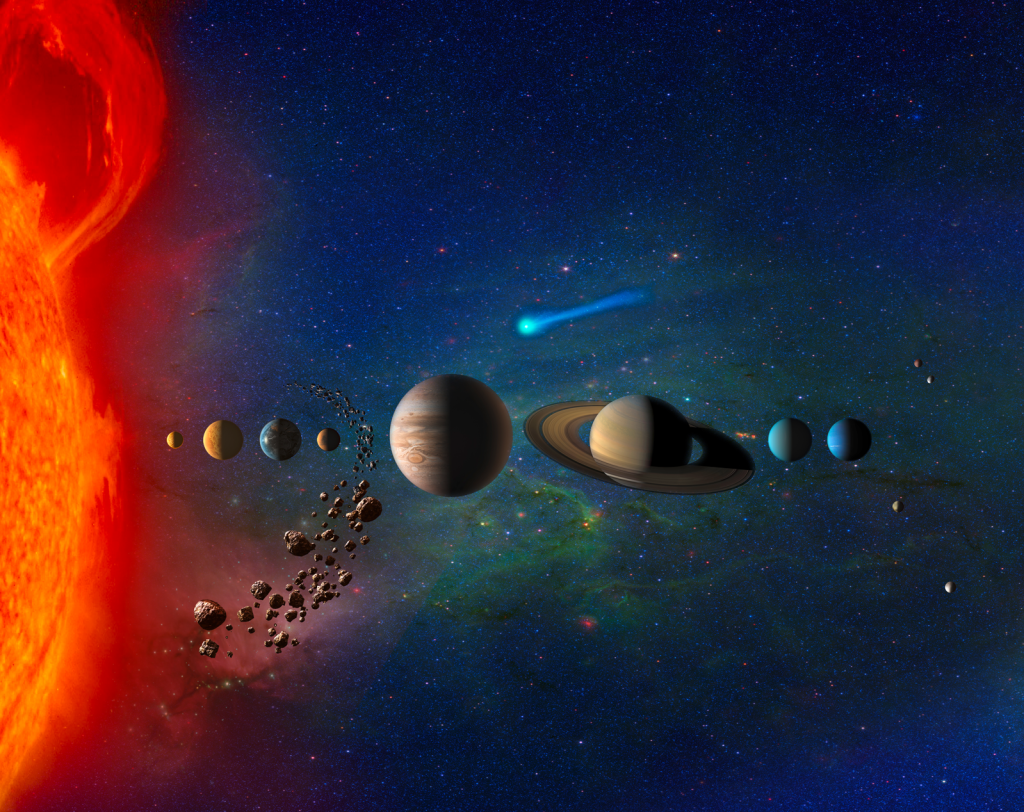Average Surface Temperatures of All Planets: Planets’ temperatures are largely influenced by their structural characteristics and proximity to the Sun, however, Venus notably presents a unique case.
Average Surface Temperatures of All Planets: There are eight planets in the solar system: Mercury, Venus, Earth, Mars, Jupiter, Saturn, Uranus, and Neptune, with Pluto now categorised as a dwarf planet.
Planets’ temperatures are largely influenced by their structural characteristics and proximity to the Sun. However, Venus notably presents a unique case, as its thick atmosphere generates a greenhouse effect, resulting in surface temperatures that exceed the melting point of lead.
Mercury, on the contrary, has a slow rotation and a sparse atmosphere, which results in the temperature difference between its day and night sides reaching more than 1000°F, with night-time temperatures plummeting to as low as -290°F (-179°C), according to NASA.
Meanwhile, Jupiter, Saturn, Uranus, and Neptune temperature readings are taken at atmospheric levels corresponding to sea level pressure on Earth.
Undoubtedly, the Sun has the hottest temperature, with its core being the hottest, where temperatures top 27 million°F (15 million°C), whereas its surface – the photosphere – is a relatively cool 10,000 °F (5,500°C).
Whereas, the Sun’s outer atmosphere, the corona, gets hotter the farther it stretches from the surface, and can reach up to 3.5 million°F (2 million°C) – much, much hotter than the photosphere.
Below is an overview of the average temperatures of the planets within our solar system, as per NASA:
The planets have been ranked according to the mean temperatures of various destinations in our solar system by NASA, with the planets not to scale. Notably, the surface temperatures of the planets decrease as the distance from the Sun increases.
| Rank | Planet/Dwarf Planet | Temperature (°F) | Temperature (°C) |
| 1 | Venus | 867°F | 464°C |
| 2 | Mercury | 333°F | 167°C |
| 3 | Earth | 59°F | 15°C |
| 4 | Mars | -85°F | -65°C |
| 5 | Jupiter | -166°F | -110°C |
| 6 | Saturn | -220°F | -140°C |
| 7 | Uranus | -320°F | -195°C |
| 8 | Neptune | -330°F | -200°C |
| 9 | Pluto (Dwarf) | -375°F | -225°C |
Source: NASA/Solar System Temperatures
Here are 10 Frequently Asked Questions (FAQs) for your blog on the average surface temperatures of planets in the solar system:
1. What factors influence the temperature of planets in our solar system?
The primary factors that influence planetary temperatures include proximity to the Sun, the planet’s atmosphere, composition, and rotation speed. The distance from the Sun plays a major role, but atmospheric conditions (like the greenhouse effect) can significantly alter a planet’s temperature.
2. Why does Venus have the hottest surface temperature despite not being the closest planet to the Sun?
Venus has a thick atmosphere made mostly of carbon dioxide, which traps heat through a strong greenhouse effect. This causes surface temperatures to rise far beyond those expected based on its distance from the Sun, even exceeding the melting point of lead.
3. Why does Mercury experience such extreme temperature differences between day and night?
Mercury has a very thin atmosphere, which is unable to retain heat. This, combined with its slow rotation (a day on Mercury lasts longer than its year), results in extreme temperature fluctuations. Daytime temperatures can soar to 800°F (427°C), while nighttime temperatures can plummet to -290°F (-179°C).
4. How are the temperatures of the gas giants like Jupiter, Saturn, Uranus, and Neptune measured?
Temperatures for gas giants are typically measured at levels of their atmospheres that correspond to sea level pressure on Earth. This is because these planets don’t have a solid surface, so the temperatures are taken from the upper layers of their gaseous envelopes.
5. Why are the temperatures of Jupiter and Saturn so much colder than Earth despite their size?
Jupiter and Saturn are gas giants, located far from the Sun. Their large size means they have a massive atmosphere, but their distance from the Sun results in much colder temperatures. Additionally, they release more heat than they absorb, likely due to internal processes like gravitational contraction and helium precipitation.
6. What is the temperature on Earth compared to the other planets?
Earth’s average surface temperature is around 59°F (15°C), which is moderate compared to the other planets. Its relatively mild temperature is a result of its optimal distance from the Sun, a balanced atmosphere, and the presence of liquid water, which helps to regulate temperature.
7. What makes Pluto’s temperature so low?
Pluto, being a dwarf planet located at the farthest reaches of the solar system, is extremely cold. Its distance from the Sun results in an average surface temperature of -375°F (-225°C). Additionally, Pluto’s thin atmosphere contributes to its inability to retain heat.
8. Why is the Sun’s outer atmosphere (the corona) much hotter than its surface?
The Sun’s corona, the outermost layer of its atmosphere, is much hotter than the photosphere (the Sun’s surface) due to complex magnetic activities and energy processes occurring in this region. The temperature in the corona can reach up to 3.5 million°F (2 million°C), much higher than the surface temperature of 10,000°F (5,500°C).
9. What are the coldest and hottest planets in the solar system?
The hottest planet in the solar system is Venus, with an average surface temperature of 867°F (464°C). The coldest planet is Neptune, with an average temperature of -330°F (-200°C).
10. How does the Sun’s temperature compare to that of the planets?
The Sun is far hotter than any planet in the solar system. Its core reaches temperatures of 27 million°F (15 million°C), whereas its surface (the photosphere) is relatively cooler at around 10,000°F (5,500°C). Even hotter temperatures are found in the Sun’s outer atmosphere, the corona.

